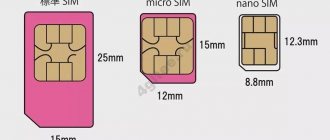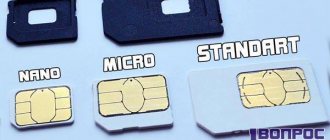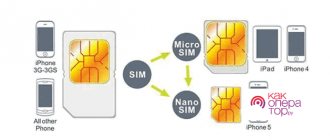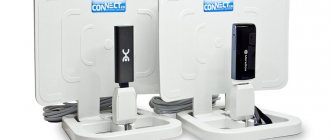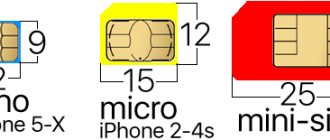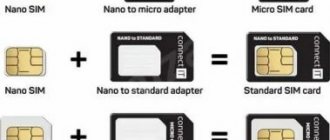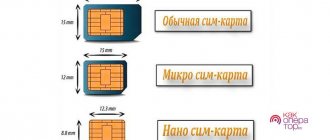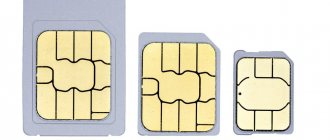With the advent of new models of phones and smartphones, new form factors for SIM cards have appeared. The standard size is practically not used. They replaced it with Micro-SIM and Nano-SIM. It is noteworthy that you can make micro from standard, and nano from micro, using a special tool or scissors. Here is a guide on how to cut a SIM card at home.
How to properly cut a SIM card
There are three accepted form factors of SIM cards. Cellular operators, when issuing new SIMs, combine two or three form factors at once, and the subscriber just has to “squeeze out” the desired size and install it in his smartphone.
Naturally, old SIM samples are not combined, so you need to trim them yourself.
The procedure will require care, because one wrong move with the scissors and the SIM card is damaged. If numbers are saved on it, it will be impossible to restore them. Before the operation, it is recommended to save the numbers in the phone's memory.
For the operation you will need:
- A SIM card of a similar format or a template for outlining.
- Pencil or knife to mark boundaries.
- A ruler if you decide to do without a template.
- Scissors to make a cut along the borders.
- Sandpaper or nail file for sanding edges.
Naturally, if there is a special cutter (stapler) for converting one SIM card format into another, then it is better to use it.
How to cut a SIM card to micro: template
You can use a special template: download, print, cut out and trace on it. Or use a pencil and ruler to trace, referring to the dimensions of the template.
The edges of the future Micro-SIM are highlighted in blue on the template. To make a micro SIM card:
- Turn the card with the contacts facing you. Using a ruler and pencil, mark 12 and 15 mm. If you are worried that you won’t be able to measure exactly, print out the template in the required proportions (or make it yourself), cut it out and mark it with a pencil.
- Using sharp small scissors or a knife, cut along the outline.
- Carefully clean any excess edges and nicks with sandpaper.
- The main thing is not to overdo it and not touch the contacts.
Creating Nano-SIM using a template
The procedure is similar. Use a template and make it from Micro - Nano.
In the case of a nano SIM card, how to trim:
- Mark 12.3mm in width and 8.8mm in length or trace using the printed template.
- Use scissors to cut without touching the contacts, and then carefully clean with a nail file.
Then insert the SIM card into the phone and check its functionality. If unsuccessful, you can contact the operator with a request to replace the physical carrier of the SIM card without changing the number.
SIM card sizes
Old SIM cards have a large chip size, exceeding the nano-standard size. But you can also cut off an old SIM card. Removing the edge of such a chip does not disrupt the operation of the contacts.
It is easier to cut out a nano-shape from a mini-SIM card, since there is a place that allows you to hold the card while manipulating with scissors. Using a utility knife will make the task much easier.
Step by step steps:
- Use a pen or thin marker to mark the new dimensions on the chip side so that you can see if the lines overlap the contacts;
- cut off the excess plastic, clamp the card itself with tongs for more precise manipulations;
- sharpen the card with a file along the contour to remove nicks, and sand the surface of the plastic on the side of the operator’s logo to make the card thinner;
- insert the SIM into the card holder; if it does not fit, repeat the previous operation until it fits completely into the slot.
If you still have unnecessary SIM cards, practice using them. The chance of the correct result of the pruning procedure will increase significantly.
Time passed, the devices changed, large SIM cards were replaced by mini-SIM cards, which today we are accustomed to consider ordinary. Further - less. Mini-SIMs are becoming less and less common, and new devices are starting to use micro-SIMs. And, it would seem, much less? But Apple decided to shrink the cards for its devices - and nano-sim appeared.
Those who had just purchased a brand new iPhone really didn’t want to wait and a pressing question arose: how to cut a micro SIM card for a nano SIM? The chip size of the SIM cards is the same, and the main problem was the amount of plastic around the edges. To reduce to nano format, you can do the following:
- perform circumcision yourself;
- take it to a workshop where the necessary tools are available;
- send it to a mobile phone store and request a replacement card.
Read about operators: How to block a Megafon SIM card temporarily or permanently
If you decide that you don’t want to do anything yourself to avoid damage, then there are two options for cutting the SIM card. You can come to a communication store, they will offer you either to completely replace the plastic, get a new SIM, which has several layers and can be squeezed out of the shell to the required format.
If you contact a mobile phone store, the exchange will be carried out absolutely free of charge. Now this takes just a few minutes. And within a day, your old plastic will stop functioning completely. If you go to a workshop or hardware store, you should know how much it costs to cut a SIM card.
Find out about ways to switch to another MTS tariff.
Cutting the SIM using a special cutter
There is a special tool - a stapler for cutting according to templates. It allows you to quickly and while maintaining ideal proportions to cut a large SIM card chip.
Execution process:
- Insert the chip into a special mold.
- Unbend the cutter and place the mold into it.
- Close and press firmly.
The risks of chip damage with such a cutter are reduced to zero. But the cost of this device significantly exceeds the cost of a SIM card. It is purchased by those who do similar things every day.
If you do not purchase a stapler, and the chip was damaged during cutting, all you have to do is contact your telecom operator to replace the SIM.
Step-by-step instruction
To cut nano sim format from a regular SIM card, you need to follow the following algorithm of actions:
- Use a pen or pencil to make marks on the surface of an old-style SIM card. The dimensions of the application are 12.3x8.8 mm. It is important to set all dimensions as accurately as possible; for this it is convenient to use a ruler with a fine scale and a caliper. You can act differently. To do this, take a template, place it on plastic and trace it, then cut it out;
- Next, excess pieces of plastic are cut off; the work must be done as carefully as possible so as not to cut off parts of the chip, otherwise it may become unusable;
- Lastly, you need to align the edges; to do this, grind off the remaining plastic with sandpaper or a nail file. You need to do everything carefully, since any damage to the chip will lead to its malfunction.
Before you try to cut a SIM card yourself, you need to weigh all the risks. It must be remembered that at home, in the absence of skills, it is easy to damage the sim.
To reduce risks, it is advisable to practice first on an old SIM card, and then, if everything works out, switch to a working one.
How much does it cost to replace a SIM card with an operator?
You can replace an old-style SIM card with a combined SIM card at your operator’s mobile phone stores. You need to have a passport or other identity document with you and preferably a phone to install the card in the SIM tray.
Replacement cost from operators for individuals:
- MTS - free.
- Beeline – 30 rubles, will be debited later from the subscriber’s account.
- Megafon is free. You can buy a heat-resistant one for 100 rubles.
- Yota is free.
- Tele2 – 50 rubles, which will be credited to the subscriber’s account.
- MOTIV - free.
- DANYCOM – free.
The cost of courier delivery is individual for each city and depends on the timing. For example, Beeline has a delivery service in Moscow, within the Moscow Ring Road, in 3.5 hours to deliver a SIM card for 530 rubles.
As for corporate clients, the clause on the cost of replacement in case of loss, damage or change to a new format is specified in the contract.
Cutting a SIM card using a template
The latest iPhone models do not use classic SIM cards, but nano-SIM. This is done for the simple reason of saving space and making the mobile device thinner. You can make a SIM card thinner in different ways.
Preparing the template
When buying a new smartphone, you can immediately cut the card to the required size in the store, but this service is paid and sometimes people do not want to resort to it. You can save money if you cut the card yourself, but you need to do it correctly, otherwise there is a high probability of damaging the chip.
The safest way is to cut the SIM card using a special template. To do this, you should print it out, select the desired size, then attach it to the SIM card and trim off the excess.
To cut, you need to prepare a sharp stationery knife or scissors with thin blades. It is necessary to carefully trim the plastic that frames the chip. In this case, the cut corner in the lower right corner should be preserved.
If, after cutting out, the SIM card does not quite fit into the slot, then it must be carefully reduced using a file or nail file.
When cutting, you cannot cut off sections of the chip. This may render the SIM card unusable.
Nano sim and micro sim - differences
Nano sim was developed not only by Apple, but also by other large companies - Motorola, RIM, Nokia and others. Apple proposed its own option, where the contact pads are located as standard, but the card itself is reduced in size.
Apple denied this option, explaining the decision by the length of the card, which could cause it to get stuck in the micro-sim slot. Through the joint efforts of RIM and Motorola, a card was released with standard pads and spare pads (in the center). The protrusion on the side, as Nokia wanted, has also been preserved.
However, Apple engineers decided to use their own version, but only for their devices. It turns out that the main difference between nano sim and micro sim is size.
Types of SIM cards
There are three main formats: mini, micro and nano. What are they?
Mini-SIM
Mini-SIM is the scientific name for a standard SIM card. Its dimensions are 25x15 millimeters.
If the phone was released before 2011 (inclusive), you can be sure that it is the Mini-SIM that is inserted into it. For modern smartphones, such a card is too large, but this does not mean that Mini-SIM is an anachronism. Standard SIM cards are used in simple dialers, in phones with large buttons for the elderly, in secure phones for fishing enthusiasts and factory workers. The listed devices cannot boast of an abundance of functions, so there is plenty of space inside their cases - in some models, manufacturers even allow you to install 3-4 Mini-SIMs.
Micro Sim
Micro is a SIM card that first appeared in the iPhone 4 smartphone from Apple. Micro SIM card size – 15 x 12 mm.
At the moment, many manufactured phones have slots for microsim installed.
After Apple, Nokia began using the microsim, and then HTC, Blackberry, and Samsung joined in, as they did not want to differ from the market leaders.
Nano-SIM
Nano-SIM is the newest and smallest phone card. Its dimensions are only 12x5 millimeters. Visually, the card is a chip with a minimum of plastic edging.
Apple is again the innovator. It was the Nano-SIM that users had to insert into the iPhone 5th modification. Later, other well-known manufacturers began to produce devices with Nano-SIM slots, for example, Samsung and Meizu.
The following illustration will help you understand the differences between the three types of SIM cards:
Table
| MicroSD | MicroSDHC | MicroSDXC |
| What do they have in common? | ||
| All types of cards are technological variations of the SD, or Secure Digital standard | ||
| Card readers for MicroSDXC can recognize MicroSD and MicroSDHC cards | ||
| Cards have the same purpose - storing data, accessed using a PC, smartphones, tablets, cameras | ||
| All types of cards have the same size - 11 by 15 mm with a thickness of 1 mm | ||
| What is the difference between them? | ||
| Compatible with any readers | Compatible only with MicroSDHC and MicroSDXC readers | Compatible only with MicroSDXC readers |
| Have a capacity of up to 2 GB | Have a capacity of 4-32 GB | Have capacities from 32 GB to 2 TB |
| Write and read data at speeds up to 25 MB/s | They have a write and read speed of 50-150 MB/s | They have a write and read speed of 50-312 MB/s |
| Cards are formatted in the FAT 12 or FAT 16 file system | Formatted in FAT 32 | Formatted in exFAT |
